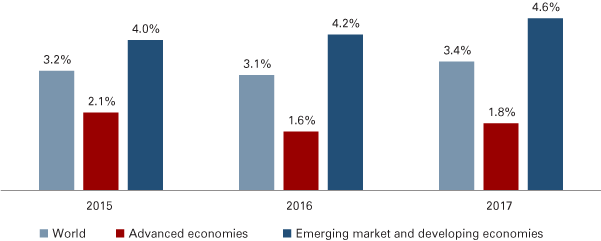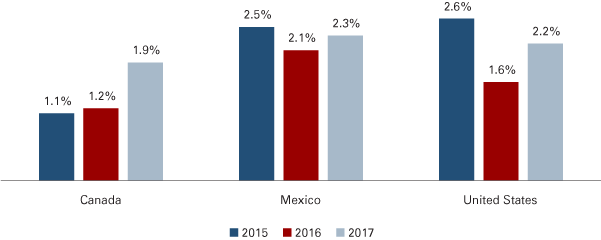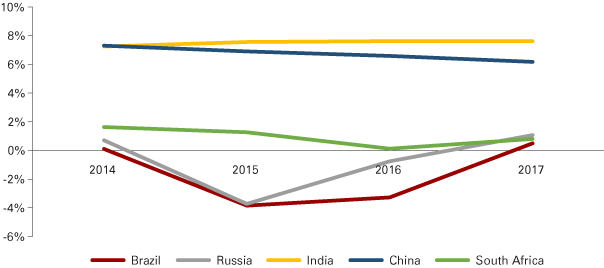International outlook for 2017
Associate Professor of Finance, Kelley School of Business, Indiana University
Clinical Assistant Professor of Business Economics and Public Policy, Kelley School of Business, Indiana University Bloomington
Prospects for a strong rebound in the global economy have dimmed, as growth outcomes in the advanced economies continue to disappoint and China continues to slow. The International Monetary Fund’s (IMF) latest forecast predicts that overall global growth will remain stuck in low gear and below its long-run average, with global output expected to rise by 3.4 percent in 2017—only marginally higher than the 3.1 percent rise seen in the previous year (see Figure 1). This global forecast balances modest growth rate increases in the U.S., Japan and some emerging markets against falling growth rates in the eurozone, the U.K. and China.
Figure 1: Global growth forecasts

Source: International Monetary Fund ("World Economic Outlook," October 2016)
United States
In 2016, solid consumption and residential investment spending has been tempered by weak nonresidential investment spending, limitations on government spending and the dollar’s continued appreciation on the export sector. Employment gains continued, with the civilian unemployment rate falling below 5 percent and labor force participation rising slightly.
Inflation is expected to rise closer to the Federal Reserve’s 2 percent target as the effects of credit easing, commodity price increases and some wage pressures begin to be reflected in the overall price level. In 2017, we expect the Federal Reserve to maintain its cautious pace of interest rate increases, and for growth to remain sluggish at just over 2 percent. Given recent trends of decreased productivity growth, this rate of economic growth is unlikely to result in significantly higher wage or labor force participation growth. In addition, with U.S. imports comprising over 15 percent of gross domestic product (GDP), sluggish growth in the U.S. will weigh on the growth prospects of its major trading partners.
Europe
In recent years, the European Union (EU)—the world’s single-largest market and a major economic and political ally of the United States—has been in the midst of a storm … a perfect storm that has included soaring national debt, weak economic growth, a large volume of refugees and the reemergence of a belligerent Russia. If that was not enough, in June 2016, the citizens of the U.K. voted to leave the EU. This latest event triggered a new wave of economic, political and institutional uncertainties in the advanced European economies. In 2017, we expect the U.K. to remove all European laws from the British statute, so the uncertainties associated with Brexit will persist at least for the first part of the year. We believe that the U.K. is heading for a “hard” Brexit, which means no tariff-free access to the European market, as well as added restrictions on labor movement.
The concerns of a severe separation from the EU diminish our outlook on U.K. growth potential in 2017, which is expected to grow by only 1.1 percent. The pound sterling has fallen to historical lows against the currencies of major trading partners, and we expect the lower exchange rate to continue over the first part of 2017 as capital continues to flow out of London. This sudden depreciation of the sterling could be regarded as a benefit for England’s external accounts in the short-run. However, it is likely that British consumers and producers will experience the negative consequences of the devaluation as import prices will increase. Since British exporters are integrated within the global supply chain, the depreciation of the currency and the corresponding increase in import prices will have large effects on export prices and will render them less competitive. Over time, the depreciation of the sterling will drive down living standards for everyone receiving sterling-denominated wages.
The advanced economies of the EU, such as Germany—the U.K.’s top import origin—will be affected by the slower growth in the U.K. Therefore, we forecast that in 2017 the advanced U.K. trading partners will experience the negative consequences of Brexit mostly because the deprecation of the sterling will slow down their exports to the U.K. However, in the longer term, it is possible that a significant number of European startups, notably in the tech industry (where free movement of labor between countries is vital), will relocate to continental Europe, providing some boost to their new hosts’ national economies.
Canada and Mexico
Our North American Free Trade Agreement (NAFTA) partners, Canada and Mexico—both oil-exporting economies—have experienced severe downturns caused by two years of global oil prices plummeting (see Figure 2).
Figure 2: NAFTA real GDP growth

Source: International Monetary Fund (“World Economic Outlook,” October 2016)
In Canada, the economy as a whole is forecasted to post a gain of 1.9 percent in 2017, as oil prices have reached their lowest limit and are trending up. This price recovery will finally put an end to the decline in business investment in energy-dependent provinces, such as Alberta. A pickup in the U.S. economy will help Canadian exports. However, the tepid increase in U.S. business investment and the slow activity in the U.S. manufacturing sector—an important market for Canadian exports of intermediate goods—will continue to contribute to the weakness of the commodity exports of Canada. The manufacturing sector, the auto sector in particular, is facing the same challenges as in the U.S., where new investment that would drive stronger GDP growth is expected to flow to lower-cost Mexico.
In 2017, the risks of recession in Mexico are low, and we expect the economy to grow by 2.3 percent. As long as the U.S. grows, it will support Mexican exports, as well as provide tourism revenues, remittances and capital investment. Our geographic proximity and trade agreement with Mexico will continue to stimulate private investment, in particular in the automobile industry. Manufacturing production will also gain competitiveness as the Mexican peso is expected to continue its depreciation. Private investment in the oil sector will see a small boost as the price of oil will continue to increase this year. Household consumption will keep up because remittances from migrant workers in the U.S. will compensate for the loss of purchasing power due to higher inflation, especially as the Fed increases their rates in 2017. However, there are downside risks to this forecast as domestic policies, such as interest rate increases and fiscal austerity, could impair economic growth and prolong the sluggishness in the economy.
The BRICS
Representing over 40 percent of the world’s population and 30 percent of the world’s GDP, BRICS (Brazil, Russia, India, China and South Africa) growth rates have historically helped counterbalance the effects of low advanced-country growth on overall global growth. However, in 2016, the slowing of China’s economy—combined with sharp recessions in Brazil and Russia, as well as near zero growth in South Africa—failed to provide the fuel necessary to boost the globe’s economic engine. Only India has exhibited strong growth in the face of slowing global demand and commodity price decreases (see Figure 3).
Figure 3: BRICS real GDP growth

Source: International Monetary Fund (“World Economic Outlook,” October 2016)
China’s growth rate is expected to continue to decline moderately, from 6.6 percent in 2016 to 6.2 percent in 2017, and inflation will remain low at around 3 percent. This slowing of China’s growth rate reflects the necessary “rebalancing” of China’s economy away from an overreliance on investment spending and exports in favor of greater consumption spending, and its transition from a manufacturing economy to one with a significant services sector. Indeed, the anticipated benefits from this transition have allowed China to remain a top destination for future foreign direct investment.
As the world’s second-largest economy, however, even small changes in China’s economic growth rate can have global repercussions. These effects have been particularly significant for China’s Asian neighbors and for commodity exporters in Latin America and sub-Saharan Africa, which have supplied the inputs for China’s production. We expect the shock of China’s slowdown on emerging markets will subside in 2017 as these countries begin to adjust to the new growth normal. Further, those countries who are net commodity importers will continue to benefit from lower commodity prices, while those economies who can take advantage of China’s transition away from labor-intensive manufacturing or who can supply the goods and services demanded by growing incomes of Chinese consumers will stand to benefit from China’s economic rebalancing.
China’s ability to guide its economy to a soft landing during this transition is not without risks. Like the advanced economies, China’s population is aging, and this demographic shift could lead to larger-than-expected decreases in workforce productivity. Regions that have a higher concentration of industries facing lower profits are seeing higher unemployment, falling property values and a deterioration of their bank balance sheets. State-owned banks, which had relied upon overly optimistic projections and an expectation of implicit government guarantees, are particularly vulnerable.
Given the current high degree of leverage, as well as the interconnectedness of China’s banks, a large negative adjustment to the financial positions of major Chinese banks could sharply curtail lending and have negative impacts on China’s economy and stock market. As we witnessed in August 2015, shocks to China’s financial markets can have global implications. Furthermore, although the addition of the Chinese renminbi (the official name of Chinese currency, of which the yuan is a unit of measure) into the International Monetary Fund’s Special Drawing Rights (SDR) basket in October 2016 was celebrated as a signal of the progress in China’s liberalization of its capital markets, continued uncertainty about the pace of liberalization could lead to accelerated capital outflows, a drop in reserves and pressures for a sudden depreciation of China’s currency.
The recent modest recovery in commodity prices should provide a small boost to the commodity-rich BRICS countries of Brazil, Russia and South Africa. In 2017, Brazil and Russia are expected to emerge from their deep recessions and experience positive, though muted, economic growth of 0.5 percent and 1.1 percent, respectively.
Brazil’s economy will benefit from the recent resolution of political uncertainty, the new government’s commitment to reducing its 9 percent inflation rate and a reduction of sovereign credit risk. Several downside risks remain, however, including its rising budget deficit (now at 10 percent of GDP), the country’s high unemployment rate and the economic repercussions of the Zika public health crisis. Brazil and its currency also remain vulnerable to sudden capital outflows should economic progress prove disappointing or if its trading partners experience slower-than-expected growth.
Russia’s economic growth will continue to be subdued by the impact of economic sanctions on investment, low productivity and the country’s dependence on the fate of oil; however, consumer spending is expected to improve as inflation and Ruble depreciation pressures subside. Still, we anticipate geopolitical tensions will continue to present significant downside economic risks, and we doubt that last year’s 69 percent drop in foreign investment flows will be reversed anytime soon.
South Africa’s economy is also expected to experience a mild rebound, with real GDP expected to rise from near zero in 2016 to 0.8 percent in 2017. The economy continues to suffer the effects of lower commodity prices, policy mismanagement and political risk, and a 25 percent unemployment rate for its working-age population. As the second-largest economy in sub-Saharan Africa after Nigeria, such low growth prospects will weigh on the growth prospects for the region as a whole.
Brazil, Russia and South Africa will all three need to undertake structural adjustments in light of China’s lower growth rate and the fact that commodity prices are unlikely to recover to their pre-2015 levels.
India, by contrast, stands out as a bright spot in the BRICS forecast, with the country’s 7.6 percent growth rate expected to continue in 2017. Positive policy actions taken by the current government to reduce inflation to just above 4 percent, reform the tax structure and reduce barriers to foreign investment flows have made India an attractive destination for foreign direct investment and will continue to support growth. India is also expected to benefit from a growing workforce and its position as a net importer of commodities.
Summary
These low, but positive, global growth prospects for 2017 are not without risks. For example, a faster-than-expected slowdown in China’s growth, a change in the U.K.’s Brexit strategy and a lower growth rate in the U.S. could all threaten the global economic forecast. Shifting interest rate expectations can increase financial uncertainty and financial market turbulence. The rise of private and public emerging market debt burdens denominated in foreign currencies will be at risk from sudden currency depreciations should sudden capital outflows occur. And, the risks of greater protectionist measures will negatively impact the global trade and investment flows necessary for global growth to return to its long-run average.
References
- International Monetary Fund, “The People’s Republic of China: 2016 Article IV Consultation,” IMF Country Report No.16/270, August 2016, www.imf.org/external/pubs/ft/weo/2016/02/.
- International Monetary Fund, “Global Financial Stability Report,” October 2016, www.imf.org/external/pubs/ft/gfsr/index.htm.
- International Monetary Fund, Regional Economic Outlooks, October 2016
- “Asia: Maintaining Robust Growth amid Heightened Uncertainty,” www.imf.org/external/pubs/ft/reo/2016/apd/eng/areo1016.htm.
- “Sub-Saharan Africa: Multispeed Growth,” www.imf.org/external/pubs/ft/reo/2016/afr/eng/sreo1016.htm.
- “Latin America and the Caribbean: Are Chills Here to Stay?” www.imf.org/external/pubs/ft/reo/2016/whd/eng/wreo1016.htm.
- World Bank Data
- Population Rankings: http://data.worldbank.org/data-catalog/Population-ranking-table.
- GDP Rankings, PPP Based: http://data.worldbank.org/data-catalog/GDP-PPP-based-table.
- Robert Skidelsky, “Why Sterling's Collapse Is Not Good for the UK Economy,” The Guardian, October 21, 2016, www.theguardian.com/business/2016/oct/21/why-pound-sterling-collapse-not-good-uk-economy-robert-skidelsky.



